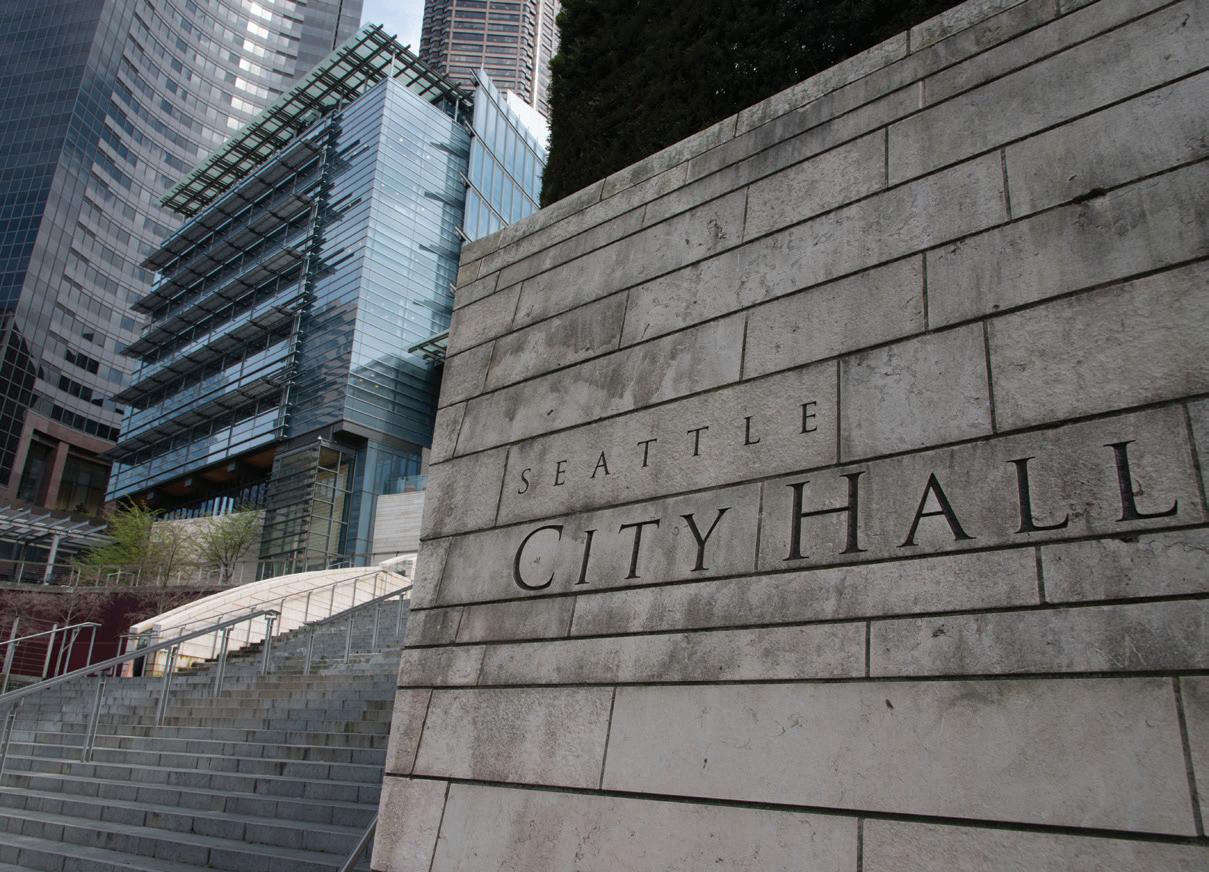MAGNOLIA VILLAGE CAR SHOW



The annual Magnolia Village Car Show is from 8 a.m. to 3:30 p.m. Sunday. It will be on West McGraw Street in Magnolia Village. It is known as a happy, casual event with classic cars, muscle cars and unusual vehicles. Many are from Magnolia owners. It is fun for car enthusiasts and enjoyable for the whole family.

Summer is so beautiful in the Pacific Northwest that it seems a shame to go away, but if you do, don’t forget to set your garden up for success.
Seattle already receives barely perceptible levels of moisture in summer from rain, so our gardens depend on us for life support during our dry season from MaySeptember. With weather patterns becoming so erratic, keeping your garden hydrated is even more critical to sustaining it during any heat dome that may roll in. You may be saying, oh, my
garden is shady and has never been irrigated or watered in summer. That’s what I used to say about the East-facing fence border in our yard. It’s got plenty of dappled tree cover, has moisture-retentive clay soil and plenty of tough mature shrubs and trees. For about ten years, I never watered that border, and still grew hosta leaves as big as my head. In the last few years however, we’ve had consistently low rainfall in winter and excess heat in summer and, in a new twist, spring. This created a double whammy of drought and heat (with a few
extended winter freezing events thrown in) that overstressed even the hardiest plants in our borders.
Despite my extra ministrations watering in summer the last two years, I lost a massive lacecap hydrangea that predated us moving in, as well as a mature variegated willow Salix ‘Haruko Nishiki.’
So, the bottom line is, if you have mature trees and shrubs that you value and you haven’t had an irrigation system the last three years, they likely need about a month of water to catch up and rehydrate their roots and surrounding soil — please give them a good soaking (even several hours) right now. I’ll wait.
Other conditions that merit extra attention include:
▶ Young seedlings, cuttings, and recent divisions. One of the biggest causes of directsown seed-starting failure is letting them dry out. Their first roots are extremely thin and fragile

Sunday Worship at 10am Live Streamed on our Facebook page and YouTube. Simply look for Magnolia Lutheran Church.
Twelfth Church of Christ, Scientist
In Person and Online Church Services
All are welcome & warmly invited to join these healing services
For best audio results, please join by clicking on the link from your computer or smartphone and choose “Call Over Internet”
All Zoom Services Meeting ID: 418 806 2637 https://us02web.zoom.us/j/4188062637
Sunday Services 11:00am – 12noon Pacific
Wednesday Testimonies 7:30pm – 8:30pm Pacific
Christian Science Quarterly Bible Lessons
Our weekly Bible Lesson Sermon may be found here: https://quarterly.christianscience.com/
Additional Healing Resources: ChristianScience.com CSWashington.com SeattleMetroReadingRoom.org
For additional assistance, please contact us at seattle12cs@gmail.com or 206.283.2300 ChristianScienceTwelfthSeattle.com
Queen Anne Dental Group

Dr. Frank J. Calvo & Family
Cosmetic, Implant, & General Dentistry
400 Boston St. 206-284-7812 www.QADG.net



Chiropractic AND Massage Therapy
Darrell Gibson, D.C. • Sarah Gibson, D.C. Graeme Gibson, D.C.
David E. Goodall III, LMT
Sarah Rose Nottingham, LMT Lauren E. Traynor, LMT
SERVING THE FAMILIES OF QUEEN ANN E SINCE 1991 1905 Queen Anne Ave N • 206.282.8275 www.QueenAnneChiro.com DENTISTS


By Carleen Johnson The Center Square
The Washington State Office of Financial Management has released its fiscal impact statement on Initiative 2117, the measure to prohibit state agencies from implementing a capand-trade program and repeal the 2021 Climate Commitment Act.
OFM’s fiscal impact statement notes that the passage of I-2117 “will reduce state revenue from carbon allowance auctions by $3.8 billion and reduce state expenditures by $1.7 billion between the effective date of the initiative and June 30, 2029.”
Todd Myers, vice president for research at the Washington Policy Center think tank, notes a repeal of the CCA would impact future spending, so there is no hole in the actual budget.
“Not surprisingly, the tax has generated more than initially expected, bringing in more than $2 billion,” Myers said. “So, it isn’t surprising that they would say, 'Look at all the spending we’re going to lose.’”
Passage of I-2117 would cut funding for more than 300 state employees, according to OFM
“These are new taxpayer-
By Spencer Pauley The Center Square
The King County Regional Policy Committee has been updated on possible plans to redevelop the county’s civic campus in south downtown, including the potential to add up to 4 million square feet of non-residential space and 13,000 homes on the public parcels.
The county owns eight square blocks there, including the office of the King County Executive, a King County Council and related staff branch office, courts and corrections.
The high-crime area is becoming a more dangerous place for citizens to come and utilize government services.
According to Wednesday's

funded positions created by CCA: people who run the CO2 tax program, distribute grant money, and those involved in various government planning, which is funded by the tax money,” Myers explained. “There’s a lot of government planning in there, so that’s where a lot of these jobs are coming from.”
OFM says the passage of 2117 would lead to some transportation projects being cut or scaled back. But those are not infrastructurerelated projects like roads and bridges; rather, they are environmental projects like $42 million for electrifying ferry docks and funding new electric ferries.
Myers questions other CCA-funded projects that
OFM says could be cut with the passage of the initiative.
“There’s a million dollars for transportation planning for the 2026 World Cup,” he noted. “What that has to do with fighting climate change, I’m not sure.”
The OFM report does not consider the CCA’s impacts on taxpayers, including higher gas prices and utility costs.
In a recent blog post, Myers lists a number of CCA projects that could be in jeopardy.
Some of those projects would fund forest health and salmon recovery, which Myers concedes should be priorities for the Legislature, regardless of funding.
“The total amount in 2025 that goes to wildfire
prevention is $7.5 million,” he said. “That’s a tiny amount of money, and there’s $7 million – almost the same amount –dedicated to algae and blue carbon projects.”
According to the state Department of Natural Resources, carbon sequestration projects “offer a significant opportunity to mitigate greenhouse gas emissions.”
“I think if you ask voters, what is more important – stopping catastrophic wildfires or putting government money into blue carbon projects – I think the answer is pretty clear,” Myers said.
The Center Square contacted Gov. Jay Inslee's office for a response to
Myers’ claims about CCA spending and received an email response from Deputy Communications Director and Press Secretary Mike Faulk.
“Transportation, as you know, is our largest source of carbon pollution,” Faulk said. He went on to say, “The CCA cap slashes pollution, and the critical revenue funds our clean transition and resilience to climate change impacts,” said Faulk.
Myers said the state will bring in less revenue if voters pass I-2117 in November, but he pointed out the state has plenty of money to go around.
“Between the 2019-21 biennium and 2023-25, the state’s operating budget increased from $51.86 billion to $71.95 billion,” Myers said.
Those figures aren’t adjusted for inflation.
“There’s no doubt there would be less money for government to spend," Myers reiterated. "But what this shows is their choices for how to spend the money are questionable.”
A recent Survey USA poll on Initiative 2117 found that 48% of likely voters intend to vote yes on the measure, 34% plan to vote no, and 18% are unsure how they will vote.
presentation, six of the eight buildings need repair, are obsolete, underutilized, or even shuttered.
The courthouse, for example, was built more than 100 years ago, and its south entrance was used to allow residents to interact with its local government. However, since the 1960s, that entrance has been used as a loading dock and a place for trash collection.
King County Councilmember Pete von Reichbauer noted the area is not as safe as it used to be.
“The courthouse should be the safest place in King County, and that has not always been the case,” Reichbauer said at the Wednesday meeting. “So I am really pleased that the executive has been working hard on trying to figure out
how we could move into the 21st century, and how we can accommodate the need to have accessibility and safety as our two features on our campus.”
Estimated costs for maintaining the eight buildings are approximately $700 million, which includes making necessary repairs or replacing aging systems.
However, if the county were to renovate the buildings, the associated costs would range from $2.5 billion to $3.2 billion. According to the presentation, this route would exclude functional improvements for courts and in-custody facilities.
King County first explored changes to its government-owned buildings in 2018 when it
kicked off the civic campus initiative. The COVID-19 pandemic halted progress on the initiative's planning stages, but in March 2023, the project team launched a series of regular engagements with the community advisory group and parallel government partners group.
The Civic Campus Planning report considers a case study in which the executive and legislative functions would remain in the downtown area, while a portion of King County’s administrative functions and the civil, criminal and legal systems be shifted to a second site in the countyowned land in the SODO District.
Potential redevelopment of county-owned buildings could also build up capacity
to deliver between 2.75 million and 4.14 million square feet of nonresidential space or between 7,000 and 13,000 new homes, according to Aaron Young, founding partner of the architecture firm Northwest Studio.
“An incredible transformation with a diverse mix of affordability levels and housing sizes,” Young said.
The outlined vision of the King County-owned space has a long road ahead. If approved, construction and occupancy are not expected until sometime between 2035 and 2040.
Plans call for developing a proposed governance structure for the project and funding and financing strategies by the end of this year.
By TJ Martinell The Center Square
A subcommittee for the Interstate Bridge Replacement Program to construct a new Interstate 5 Bridge across the Columbia River from Vancouver to Portland has adopted recommended tolling scenarios for consideration by the Washington and Oregon Transportation Commissions.
The four scenarios unanimously adopted by the Bi-state Tolling Subcommittee at its July 19 meeting offer the commissions a variety of different rates that vary not only depending on the status of the bridge’s completion, but how the rates are adjusted during weekends in response to traffic levels.
One scenario would have the toll rate be between $1.55 and $3.20 until the bridge is completed, at which point the maximum toll rate would go up to $3.65; that same scenario would have the toll rate increase by 2.15% annually,

while providing a 50% discount for low-income drivers upon the bridge's completion.
The scenario with the highest rates would rage from $2 to $4.75 prior to the bridge’s completion, yet that rate would remain once it’s finished. The toll rate would increase by 3% every two years, while it would break
up weekend rates into three separate categories.
Three of the four scenarios would have the same truck toll rates that would be either 1.5 or three times the regular toll rate.
The tolling program is one piece of the financial puzzle to cover not only the cost of the bridge’s construction but it’s ongoing maintenance and
preservation. According to bridge replacement planners, the toll program will need to provide at least $1.24 billion in capital funding for the bridge’s construction, while also generating enough revenue to meet future financial obligations.
In addition to $600 million obtained through a National Infrastructure
Project Assistance program grant, the project recently secured $1.5 billion in Bridge Investment Program funding.
The state transportation commissions will ultimately vote to adopt tolling rates before the program begins. They are scheduled for a joint meeting on Oct. 1 to be held in Vancouver.








By Spencer Pauley The Center Square
The Seattle Public Safety Committee is recommending approval for a proposed pilot program that would see some misdemeanor offenders spending time at the South Correctional Facility, or SCORE.
The pilot program is meant to be an alternative to jailing repeat offenders and is part of a plan to be more consistent in responding to misdemeanors.
The program would include an interlocal agreement with SCORE in Des Moines, including authorizing Seattle to use at least 20 beds at the facility. The facility has 802 beds, including a 29-bed medical observation unit.

SCORE would house misdemeanor detainees for 24 to 48 hours, as well as misdemeanor arrestees who would be taken to the facility if arrested for a misdemeanor crime that warrants detention under specific public safety conditions, according to a presentation.
The city currently contracts with the King County Correctional Facility. Seattle’s average number of misdemeanor
GRIVAS from Page 1Æ
and vaporize quickly without water. They may need water daily or more often depending on the heat and soil conditions.
▶ Fruiting or flowering plants grown for harvest. This could be your veggie and cutting garden plants as well as berry shrubs or fig trees – which with luck have some fruit swelling in August.
▶ Potted plants and hanging baskets, or plants in rockeries with little soil. Soil acts as an insulator and a hydrating sponge around plant roots, so pots don’t have as much moisture to draw upon, needing watering daily in hot weather.
▶ Plants in sandy soil – it releases water almost instantly. (Adding organic matter on top, whether compost, “Soil conditioner,” or natural bark mulch will help retain some water.)
▶ Plants without groundcover or mulch surrounding them to protect the soil from evaporation.
▶ Plants added to your garden or transplanted within the last two years. Similar to the seedling roots, plants need at least two seasons of regular watering to “establish” in their new spot.
▶ Plants that are struggling (unless, of course they are suffering from overwatering, as in a pot without sufficient drainage holes).
▶ Plants that love water and hate to dry out. Examples include
offenders held in jail in 2023 was 180, which is half of what it was in 2019, with 75. All the while, there is a lack of available correction officers.
Cost estimates range from $1.5 million to $3 million per year, depending on utilization rate. The facility’s jail beds would be paid for with underspent funds from the city’s King County
fuchsias, ligularia, and ferns.
Now that we’ve covered all the reasons to water, and which plants need some extra babying, here are some strategies to help them through your vacation.
If time and means allow, set up an irrigation, soaker hose, or sprinkler systems on timers – even if only for your most vulnerable plants. Early morning is the best time to water to avoid water evaporating in the heat and or water sitting on the leaves in cool conditions overnight which can promote fungal issues.
Other options to consider include digging in ollas – clay vessels that slowly disperse water over about a week or “plant nannies” in the form of wine or plastic bottles inserted into a clay cone in the ground. Ollas can be homemade by gluing two clay flat-bottomed pots together and sealing the bottom drainage hole with a cork or you can purchase them from various companies –you’ll need more for larger areas. Another choice which looks silly but can do in a pinch – get plastic kiddie pools for groups of you potted plants and let them drink from the bottom up for ten days or so.
Mulching with bark, grass clippings, shredded leaves, or straw will help retain a lot of moisture in the soil for in-ground and potted plants. You can also hire help or bribe neighbors to hand-water (note
jail contract. The cost for 20 beds in the prison from September through December is estimated to total $600,000.
In 2025, the beds would be paid for as part of the general fund.
In a previous public safety committee meeting on July 23, Seattle City Attorney Ann Davison said Seattle police officers are not able to book over half of the city’s misdemeanor crimes listed in the city’s laws. This includes: theft, trespassing, harassment, property destruction and animal cruelty, among others.
This is a result of an executive order issued by King County Executive Dow Constantine in March 2020 that sought to reduce the jail population due to the COVID-19 pandemic. Constantine’s executive order limited misdemeanor
you may have to offer to watch their Bernese Mountain Dog the next time they go away).
No matter which you choose, before
bookings to the following: misdemeanor assaults; violations of no contact or protection orders; driving under the influence; sex crimes; and other charges presenting a serious public safety concern.
The booking restrictions were slightly loosened in February 2022, but remain in place.
During the Seattle Public Safety Committee meeting on Wednesday, public commenters were split on the proposed bill. Some argued that the bill does not help address the root cause of crime, while those in favor of the bill say crime in their neighborhoods are worsening and they feel unsafe.
The committee voted 4-0 in favor of Council Bill 120825 on Wednesday with one abstention. The legislation will now face a final vote by the full Seattle City Council at a later date.
you head to the airport, drench your garden and pots with a loooonnnnggg watering to give it a good reserve from which to draw.

Jan Jacobson Bomengen of Magnolia went to join the Lord and her beloved husband John on June 11, 2024. Nearly a life-long resident of Seattle’s Magnolia neighborhood, Jan was born to Helen & Russ Jacobson on Dec. 6, 1939. Jan had a real joy in living and was genuine, friendly and always enthusiastic. An athlete before women were generally recognized for athleticism, she was a champion ice skater, having achieved national ranking as a pairs skater and coming whisperclose (fourth in line) to go to the Olympics in Brussels. After retiring from skating, she became a judge at competitions. Always modest, Jan denied having the sweetest swing in golf and rose to become 1995-96 Women’s Golf “Captain” (president) at the Seattle Golf & Country Club. She was an alumna of the U-Dub’s Pi Beta Phi sorority (pledged in 1958), graduating with a degree in Elementary Education. As a young woman, Jan taught primary grades, including 2nd and 3rd graders. Proudly Norwegian, Jan loved serving lutefisk at Christmas time, always decorating her table with miniature Norwegian flags. Jan served as “Queen of Magnolia” for the summer celebration and worked at her Dad’s store, Le Roux’s Men’s Wear, starting in 1980, later adding a popular women’s line. Jan was an only child, leaving behind a cousin, Gary Jacobson, of Nebraska. Jan will be remembered as having a constant smile and for being kind, loving and generous to everyone even as late-in-life dementia robbed her of so many of her other talents. A memorial service is being planned.
11.40.051 and 11.40.060. This bar is effective for claims against both the Decedent’s probate and non-probate assets. Date of First Publication of this Notice: July 31, 2024 Prepared By: W. TRACY CODD WSBN 16745 Attorney for Personal Representative P.O. Box 1238 Seahurst, WA. 980621238 (206) 248-6152 Published in the Snohomish County Tribune July 31, August 7 & 14, 2024
SUPERIOR COURT OF WASHINGTON FOR KING COUNTY IN PROBATE Estate of KATHLEEN CLEMENTS, Deceased. No. 24-4-050385SEA PROBATE NOTICE TO CREDITORS RCW 11.40.030 THE PERSONAL REPRESENTATIVE
NAMED BELOW has been appointed and has qualified as Personal Representative of this estate. Any person having a claim against the decedent must, before the time the claim would be barred by any otherwise applicable statute of limitations, present the claim in the manner as provided in RCW 11.40.070 by serving on or mailing to the personal representative or the personal representative’s attorney at the address stated below a copy of the claim and filing the original of the claim with the court in which the probate proceedings were commenced. The claim must be presented within the later of: (1) thirty days after the personal representative served or mailed the notice to the creditor as provided under RCW 11.40.020(3); or (2) four months after the date of first publication of the notice. If the claim is not presented within this time frame, the claim is forever barred, except as otherwise provided in section 11 of this act and RCW 11.40.051 and 11.40.060. This bar is effective as to claims against both the decedent’s probate and non-probate assets. Date of First Publication: July 31, 2024
WILLIAM P. CLEMENTS, Personal Representative Attorney for Personal Representative: Cory A. McBride WSBA# 49714 Address for Mailing or Service: 4218 S.W. Andover Seattle, WA 98116 Published in the Queen Anne & Magnolia News July 31, August 7 & 14, 2024
SUPERIOR COURT OF WASHINGTON FOR KING COUNTY IN THE MATTER OF THE ESTATE OF JAMES D. NASH, Deceased. No. 24-4-05052-1 SEA PROBATE NOTICE TO CREDITORS RCW 11.40.030 The personal representative named below has been appointed as personal representative of this estate. Any person having a claim against the decedent must, before the time the claim would be barred by any otherwise applicable statue of limitations, present the claim in the manner as provided in RCW 11.40.070 by serving on or mailing to the personal representative or the personal representative’s attorney at the address stated below a copy of the claim and filing the original of the claim with the court. The claim must be presented within the later of: (1) Thirty days after the personal representative served or mailed the notice to the creditor as provided under RCW 11.40.020 (1) (c); or (2) four months after the date of first publication of the notice. If the claim is not presented within this time frame, the claim is forever barred, except as otherwise provided in RCW 11.40.051 and 11.40.060. This bar is effective as to claims against both the decedent’s probate and nonprobate assets. Date of First Publication: 8/7/2024 Personal Representative: AARON WEST Attorney For Personal Representative: GEIR T. JONSSON, WSBA #29112 OF THE JONSSON LAW FIRM, PLLC Address For Mailing or Service: THE JONSSON LAW FIRM, PLLC 1455 NW Leary Way, Suite 400 Seattle, WA 98107 Published in the Queen Anne & Magnolia News August 7, 14 & 21, 2024 Superior Court of Washington, County of King In re: Petitioner/s (person/s who started this case): Habtam Gobezie And Respondent/s (other party/ parties): Bisrat Mesfin No. 24-3-03037-2 Summons Served by Publication (SMPB) Summons Served by Publication To (other party’s name/s): Bisrat Mesfin I have started a court case by filing a petition. The name of the Petition is: Gobezie vs Mesfin You must respond in writing if you want the court to consider your side. Deadline! Your Response must be filed and served within 60 days of the date this Summons is published: July 24, 2024. If you do not file and serve your Response or a Notice of Appearance by the deadline: • No one has to notify you about other hearings in this case, and • The court may approve the requests in the Petition without hearing your side (called a default judgment). Follow these steps: 1. Read the Petition and any other documents that were filed at court with this Summons. Those documents explain what the other party is asking for. 2. Fill out a Response on this form (check the Response that matches the Petition): [x] L Divorce 211, Response to Petition about a Marriage. You can get the Response form and other forms you may need at: • The Washington State Courts’ website: www. courts.wa.gov/forms • Washington LawHelp: www.washingtonlawhelp.org or • The Superior Court Clerk’s office or county law library (for a fee). 3. Serve (give) a copy of your Response to the person who filed this Summons at the address below, and to any other parties. You may use certified mail with return receipt requested. For more information on how to serve, read Superior Court Civil Rule 5. 4. File your original Response with the court clerk at this address: Superior Court Clerk, King County 516 3rd Ave. Seattle WA 98104 5. Lawyer not required: It is a good idea to talk to a lawyer, but you may file and serve your Response without one. Person filing this Summons or his/her lawyer fills out below: /s/ Habtam Gobezie Date 07/03/2024 I agree to accept legal papers for this case at (check one): [x] the following address (this does not have to be your home address): 3565 S Morgan St Seattle WA 98118 (If this address changes before the case ends, you must notify all parties and the court in writing. You may use the Notice of Address Change form (FL All Family 120). You must also update your Confidential Information Form (FL All Family 001) if this case involves parentage or child support.) Note: You and the other party/ies may agree to accept legal papers by email under Superior Court Civil Rule 5 and local court rules. This Summons is issued according to Rule 4.1 of the Superior Court Civil Rules of the state of Washington. Published in the Queen Anne & Magnolia News July 24, 31, August 7, 14, 21 & 28, 2024
By Carleen Johnson The Center Square
The Biden administration’s final rule for Title IX extending federal protections for LGBTQ+ students went into effect nationwide Thursday, including in Washington state. Meanwhile, a slew of legal challenges has temporarily blocked more than half of all states from enforcing the updated regulations.
Title IX is a landmark federal civil rights law enacted as part of the Education Amendments of 1972. It prohibits sex-based discrimination in any school or other education program that receives funding from the federal government.
A flurry of legal challenges in various states contend that the changes violate the principles of Title IX and accuse the federal government of overstepping its authority.
The Biden administration says the changes promote equity and opportunity for students across the country, as well as accountability and fairness.
David Spring, executive director of the Washington Parents Network, argues the motives of the rule change are clear: to promote the transgender movement.
WPN had planned to file a motion for a temporary injunction to stop the rule changes, but a court ruling out of Alabama halted those plans.
“All the other courts had granted injunctions to stop the rule, and we
assumed the Alabama court would do the same,” Spring told The Center Square.
In an email to supporters, Spring wrote, “To my shock and horror, instead of granting the injunction – as all the other seven federal judges had done – the Alabama judge wrote 120 pages of the most incomprehensible mumbo jumbo I have ever read.”
Spring pointed out two examples of what he sees as glaring contradictions in the ruling.
“First, the judge acknowledged that Title IX requires single-sex bathrooms and that 'sex' referred to biological males versus biological females,” he said. “But then she claimed it was ‘reasonable’ to allow transgender biological males in the girls' bathrooms.”
Spring went on to say, “The Biden rule change allows a Title IX coordinator to charge a student or teacher who failed to use someone’s preferred pronoun even a single time with sexual harassment. The same Title IX coordinator would then be in charge of the investigation, which could be done in secret. The same Title IX coordinator would be the judge and jury and could find any teacher or student guilty of sexual harassment, ruining the teacher or student’s reputation for life!”
Not following these rules could be interpreted mean violating federal law, potentially resulting in sexual harassment charges or a loss of
funding.
Spring said all hope is not lost.
“The 11th Circuit [Court of Appeals] granted Alabama and other states a seven-day emergency injunction against the Alabama judge’s ruling,” he noted.
So whether or not WPN files an appeal depends in part on how the court’s three-judge panel rules next week.
The U.S. Supreme Court has also signaled it may take up the case as early as October.
The Center Square reached out for comment to OSPI and State Superintendent of Public Instruction Chris Reykdal and received the following response via email:
"All students in Washington state and across the U.S. deserve access to a high-quality education that is free from discrimination, and Title IX is just one of many protections to ensure that happens. For more information about impacts of the rule changes to Washington's schools, please see the guidance OSPI issued in early July."
David Olson, Peninsula School District board member, is running to be the next state superintendent.
He told The Center Square he is hopeful the rule changes won’t be fully implemented.
“As these changes take effect and more states sue to stop them, I think there will be a cascading effect of districts not complying with changes made by Biden to Title IX,” Olson said.
By Carleen Johnson The Center Square
Members of the Long-Term Services and Supports Trust Commission got an update this week on revenue collections from WA Cares, the state's mandatory long-term care insurance program.
The program is funded by a payroll tax of 58 cents for every $100 dollars earned. After a certain number of years paying in, it offers a maximum lifetime benefit of $36,500 to offset costs associated with long-term care.
Luke Masselink, senior actuary with the Office of the State Actuary, told lawmakers premium revenue is coming in higher than projected.
"But just because this revenue is coming in higher, that doesn't automatically meant that the financial projections when they get updated later this year are going to improve in a similar fashion," he said.
Variability remains a factor.
“It's hard to say, based on one year of experience, if this is a sustained deviation or if it's just something more short term,” Masselink said. “There also remains a lot of uncertainty around projected costs for this program.”
Projections for the first 12 months of WA Cares collections were $950 million.
WA Cares Director Ben Veghte told members, “Once four quarters are collected [through the end of 2024] it should be about $1.3 billion.”
That would be about $350 million more than expected.
Sen. Karen Keiser, D-Des Moines, asked Ibrahim Dembele of the Employment Security Department about administrative costs in running the program.
"So far, we are retaining about 25 percent,” Dembele replied, which raised eyebrows among commission members.
“How much, 25 percent?” asked Keiser.
“The Employment Security Department is keeping 25 percent, yes,” he responded.
Keiser pressed again.
“But wait, administrative expenses? You can’t be getting 25%,” said the senator. “That seems excessive, to say the least.”
Dembele then said he would provide members with a complete financial accounting at the next meeting.
“If you want to break down all the calculations, I can immediately send
after this meeting, how we are calculating that,” Dembele said.
Keiser said she would appreciate that.
“ESD is a passthrough agent and not actually administering anything,” she said. “DSHS actually administers the program.”
Veghte then chimed in.
“And ESD has a team doing a lot of administrative things as well: collecting premiums, administering exemptions, and so forth,” he explained.
He went on to say ESD keeps up to 25% as a cushion in case of unexpected expenses, but said actual administrative costs are much lower.
Other members continued to press, urging ESD officials to provide that breakdown of expenses and any additional revenue being set aside, suggesting that keeping 25% is unnecessary.
Veghte attempted to allay their concerns.
“I could just say that that, you know, we collected $1.3 billion this year and the administrative expenses were, you know, a tiny fraction of that, probably around 6 or 7 percent – 5, 6, 7, 8%," he said. “I don't have the exact number, but it's not 25%.”
By Lynda Balslev
Who doesn't like melty, gooey cheese? Nearly no one, we might venture. However, in the case of applying direct heat and the fire of a grill, the concept of cooking a hunk of cheese and then watching it dissolve into a bubbling ooze of dribble on the grill grates isn't ideal. No worries: There is a cheese for this conundrum, and it's called Halloumi.
Halloumi is a unique Cypriot cheese that is made by cooking strained and pressed milk curds in boiling whey. Since it's prepared with such high heat, Halloumi maintains its shape when exposed to high heat during cooking. In other words, it's unmeltable. This allows it to be grilled and seared without liquifying into a puddle — perfect for skewering, grilling directly on the grates or an even sear in a skillet. Heck, you can even fry it.

While this cheese remains firm, it does not mean you will be chewing on a squeaky rubber band. Although Halloumi won't melt, it does, in fact, soften and relax, transforming into a tender, satisfying bite. It's also naturally briny and salty, which adds seasoning and contributes to the overall flavor of a composed dish — or in the case of this recipe, a hearty salad.
Active time: 30 minutes
Total time: 30 minutes
Yield: Serves 4
Dressing:
▶ 1/3 cup extra-virgin olive oil
▶ 3 tablespoons fresh lemon juice
▶ 1 garlic clove, minced or pushed through a press
▶ 2 teaspoons honey
▶ 1 teaspoon Dijon mustard
▶ 1/2 teaspoon sweet paprika
▶ 1/4 teaspoon ground cumin
▶ 1/4 teaspoon kosher salt
▶ 1/4 teaspoon freshly ground black pepper
▶ 1 1/2 cups red quinoa
▶ 1/2 teaspoon kosher salt, or more to taste
▶ 2 (8-ounce) packages Halloumi
▶ Extra-virgin olive oil
▶ 1 red bell pepper, thinly sliced
▶ 1/2 small red onion, thinly sliced
▶ 1/2 cup Italian parsley leaves, chopped, plus more for garnish
▶ 1/2 cup cilantro leaves and tender stems, chopped, plus more for garnish
▶ 1/2 teaspoon lemon zest
▶ 8 to 10 cherry or grape tomatoes, halved
▶ 2 tablespoons chopped toasted almonds
Whisk the dressing ingredients in a small bowl. Rinse the quinoa in a finemesh sieve. Transfer to a medium saucepan and cover with 2 inches of water. Bring to a boil and simmer until the quinoa seeds release their germ (white tail), about 12 minutes. Drain the quinoa and rinse under cold water. Transfer to a bowl. Stir in 2 tablespoons of the dressing. Season with salt.
Cut the Halloumi into 1/2-inchthick slices. Blot dry with paper towels, then lightly brush with oil. If using a grill, grill the Halloumi over direct medium heat until it's well-marked, 6 to 8 minutes, turning once. If cooking on the stovetop, heat a cast iron skillet over mediumhigh heat. Add the Halloumi and sear until golden brown on both sides, about 6 minutes. Remove the Halloumi from the grill or skillet and brush with some of the dressing. Add the red pepper, onions, parsley, cilantro and the lemon zest to the quinoa and stir to combine. Spread the quinoa in a shallow serving bowl or divide between serving plates. Arrange the Halloumi and tomatoes over the salad. Sprinkle with the additional parsley and cilantro and garnish with almonds. Drizzle with the remaining dressing to taste.
Lynda Balslev is an award-winning writer, cookbook author, and recipe developer based in northern California. Visit TasteFood at TasteFoodblog.com.